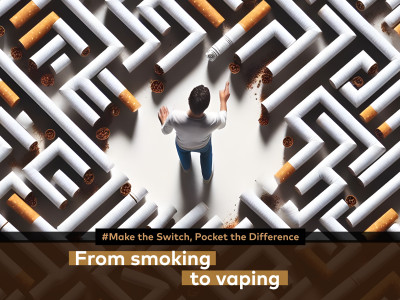Starting with their conclusion, in Risky business: a longitudinal study examining cigarette smoking initiation among susceptible and non-susceptible e-cigarette users in Canada, Aleyan et al. write: “e-cigarettes are expanding the tobacco cigarette market by attracting low-risk youth who would not have otherwise tried using cigarettes.”
The group concludes: “These findings reinforce the need to adopt regulations aimed at reducing the appeal of e-cigarettes and deterring use among youth populations. Additionally, our results point towards the need for sustained efforts focused on deterring the use of all forms of tobacco products, including e-cigarettes.”
The problem with statistics is that they can be skewed to support a particular idea or desired outcome. This is something that supporters of this study (like Martin McKee and Simon Chapman) frequently engage in. Also, there are issues regarding the selective quoting of other studies.
As one example, this study refers to Stratton et al. Public Health Consequences of E-Cigarettes to support the notion that there are valid and strong arguments against the use of ecigs. The Ontario researcher write: “While some evidence does exist to support the potential of e-cigarettes to be used as smoking cessation aids and help reduce smoking-related harms among adults, others have argued against this considering the limited evidence of the long-term effects of e-cigarettes.”
This is an over-simplification. Giving the impression that Stratton et al.’s work debunks the benefits of vaping is a gross piece of misdirection. Taking the section on teens and a possible gateway effect (seeing that this is what Aleyan al’s paper is about), it actually talks about the benefits of vaping for teens and ecigs acting as a disruptive technology in Chapter 16:
“Preventive Effect: E-cigarette use could have a preventive effect that deters ever combustible tobacco cigarette use (i.e., probability of transition is lower for Path 2a than 2b, holding all external confounds constant). Some have proposed that for “high-risk” youth with a disposition toward risk-taking behavior (e.g., impulsive personality, novelty-seeking tendency) who are susceptible to smoking initiation, e-cigarettes may provide a diversion that prevents them from experimenting with harmful combustible tobacco products (Etter, 2017; Kozlowski and Warner, 2017).”
“Known sometimes as the ‘diversion hypothesis’, this concept proposes that because some youth possess an elevated drive to engage in exploratory and risk-taking behavior, the availability of e-cigarettes allows such young people to satisfy their curiosity and drive for novelty seeking without needing to resort to combustible tobacco products to satisfy the desire for exploration (Etter, 2017; Kozlowski and Warner, 2017).”
“The diversion hypothesis also proposes that if e-cigarettes were otherwise unavailable, youth prone to risk-taking behavior would be more likely to use combustible tobacco products due to the absence of a suitable non-combustible tobacco substitute (Etter, 2017; Kozlowski and Warner, 2017). In such a case, regulatory policies that reduce e-cigarette use in the population of adolescent and young adult never smokers could indirectly increase the prevalence of smoking and perpetuate the epidemic of tobacco-related illness.”
Reference to this section would have holed the Canadian research below the water line, so they didn’t do it. They don’t consider that non-smoking teens may not be non-smoking teens in the future – regardless of vaping existing.
The fact that the researchers don’t even know if the teens used “flavoured/non-flavoured, with/without nicotine, mod/tank”, and “the study was not able to assess the reasons behind e-cigarette use among the baseline sample of current e-cigarette users”, means it really offers very little by way of substance.
Moreover, by their own admission, “The study findings demonstrated that only a small percentage of non-smoking students reported using e-cigarettes in the past 30 days (4.0%).” And that is EVER use, not even regular daily vaping.
So, while the portly Martin McKee trumpets that this is “yet more evidence that e-cigs are a gateway to smoking for adolescents”, and the rabid Simon Chapman sneers that the “cult-like doctrinaire veneration of ecigs…will see giant eggs on faces”, the paper is nothing of the sort. In fact, it is so nowhere near proof of a gateway effect that one might wonder if they read beyond the headline?
The authors of the report, as well as McKee and Chapman, could do a lot worse than read an old article in the New York Times by Aaron E. Carroll, a professor of paediatrics at Indiana University School of Medicine.
With reference to scare stories about alcohol and cancer, he wrote: “A more nuanced discussion of risk — and how we communicate it — can leave us much happier, and perhaps healthier.”
Vapers appreciate that vaping isn’t “safe”, and most welcome balanced research and calm, meaningful media coverage. “Depending where you look,” continues Carroll, “you can find evidence that says that nearly everything we eat is both associated with higher rates of cancer and lower rates of cancer.”
Doesn’t this sum up how studies like this one from Canada are being conducted?
The anti-vaper agenda is served by massaging percentages until they are media friendly, yet Carroll highlights: “A 30 percent increase in risk sounds scary, but an increase from 1 percent to 1.3 percent absolute risk does not, though these are the same things.”
Those pushing the Canadian paper as though it is another nail in harm reduction’s coffin are doing nothing more than engaging in trolling and intellectual dishonesty. It is high time these people were publicly held to account by journals and their peers.
Photo Credit:
Images from Twitter and the homepage for the Canadian study, linked in the text.
Dave Cross
Journalist at POTVDave is a freelance writer; with articles on music, motorbikes, football, pop-science, vaping and tobacco harm reduction in Sounds, Melody Maker, UBG, AWoL, Bike, When Saturday Comes, Vape News Magazine, and syndicated across the Johnston Press group. He was published in an anthology of “Greatest Football Writing”, but still believes this was a mistake. Dave contributes sketches to comedy shows and used to co-host a radio sketch show. He’s worked with numerous vape companies to develop content for their websites.
Join the discussion
Parliament Fears Two
The Department for Environment, Food and Rural Affairs faced questions from a Conservative MP and, oddly, a member of the Department for Environment, Food and Rural Affairs
Harm Reduction For The Rich
The United Kingdom risks becoming a harm reduction country only for the wealthy, according to Michael Landl of the World Vapers’ Alliance
Sacrificing Health For 2p Cut
Tory Government alienates vaping voters with its mission to cut tax by an unaffordable 2p to attract voters by placing a tax on vape products in the forthcoming budget
Scotland Announces Single-Use Vape Action
A ban on the sale and supply of single-use vapes in Scotland is due to come into effect on 1 April 2025, under proposed legislation published today












